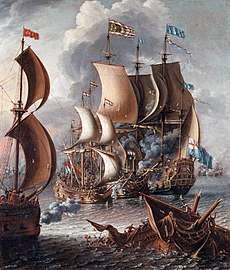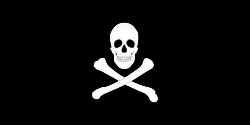Samuel Pallache
Samuel Pallache (Arabic: صامويل آل بالاتش, Shmuel Baylash, Hebrew: 'שמואל פאלאץ, Shmuel Palach, c. 1550 – February 4, 1616) was a Jewish Moroccan-born merchant, diplomat, and pirate of the Pallache family, who, as envoy, concluded a treaty with the Dutch Republic in 1608.[1] He is likely an ancestor of Haim Palachi of 19th-century Izmir.
Samuel Pallache | |
|---|---|
 "Man in Oriental Costume" by Rembrandt ca. 1633-1634, thought to be Samuel Pallache | |
| Born | circa 1550 Fez, Morocco |
| Died | February 4, 1616 The Hague, Netherlands |
| Burial place | Beth Haim of Ouderkerk aan de Amstel |
| Other names | alternative spellings of surname: Palache, Palacio, Palatio, Palachio, Palazzo[1] |
| Years active | 1580s - 1616 (death) |
| Known for | Moroccan-Dutch trade agreement (1608) |
Notable work | first Portuguese minyan Amsterdam[2] |
| Criminal charge(s) | Piracy |
| Criminal penalty | Case dismissed |
| Spouse(s) | Reina (Hebrew Malca) |
| Children | Isaac (and Jacob/Carlos) |
| Parent(s) | Isaac Pallache, rabbi |
| Relatives | Joseph Pallache (brother) and nephews Isaac, Joshua, David, Moses, Abraham |
| Family | Pallache family |
Background
Pallache was born in Fez, Morocco. His father, Isaac Pallache, was a rabbi there, first mentioned in takkanot (Jewish community statutes) in 1588. His brother was Joseph Pallache. His uncle was Fez's grand rabbi, Judah Uziel; his son Isaac Uziel was a rabbi of the Neve Shalom community in Amsterdam.[1]
His family originated from Islamic Spain, where his father had served as rabbi in Córdoba. According to Professor Mercedes García-Arenal, "The Pallaches were a Sephardi family perhaps descended from the Bene Palyāj mentioned by the twelfth-century chronicler Abraham Ibn Da’ud as 'the greatest of the families of Cordoba'."[3] In the first half of the 16th century, following the Christian conquest of Islamic Spain (the Reconquista), the family fled to Morocc, where Jews, like Christians, were tolerated as long as they accepted Islam as the official religion.
Pallache's surname is spelled "Palache" on his death certificate.[4] He signed his name also as "Palacio" and "Palatio"; other Dutch records show "Palatio," "Palachio," and "Palazzo."[1]
Career

Pallache arrived in the Netherlands between 1590 and 1597.[5] In 1591, Middelburg offered him residential permit, but Protestant pastors protested.[6][7]
After a delegation from the Dutch Republic visited Morocco to discuss a common alliance against Spain and the Barbary pirates, sultan Zidan Abu Maali in 1608 appointed the merchant Samuel Pallache to interpret for his envoy Hammu ben Bashir to the Dutch government in The Hague.[8] Officially, Pallache served as the sultan's "agent", not ambassador.
On June 23, 1608, Pallache met stadholder Maurice of Nassau and the States-General in The Hague to negotiate an alliance of mutual assistance against Spain. On December 24, 1610, the two nations signed the Treaty of Friendship and Free Commerce, an agreement recognising free commerce between the Netherlands and Morocco, and allowing the sultan to purchase ships, arms and munitions from the Dutch.[9] This was one of the first official treaties between a European country and a non-Christian nation, after the 16th-Century treaties of the Franco-Ottoman alliance.
The story goes that, one day, Pallache's horse-drawn carriage met the carriage of the Spanish ambassador in The Hague. The two carriages were unable to pass one another and, to cheers from onlookers, the Spanish ambassador's carriage had to make way for Pallache's carriage.[8]
Research has shown that Pallache secretly acted as a double agent. He maintained close ties with the Spanish court and passed classified information about Dutch-Moroccan relations on to the Spanish. At the same time, he was passing information about Spain back to the Dutch and Moroccans. When this eventually came to light, he fell out of favor with the sultan.
In addition to his diplomatic affairs, Pallache also continued his activities as a merchant, actively trading between the Netherlands and Morocco. He also got permission from Prince Maurice for privateering activities. The goods obtained through these pirating activities were sold along the Moroccan coast.
Death
In 1614, Pallache, having captured a Portuguese ship, was unable to bring its cargo ashore in Morocco and so sailed for the Netherlands. A heavy storm forced him to seek refuge in an English port where, by request of the Spanish ambassador, he was arrested and imprisoned. Eventually, Prince Maurice came to his aid and helped bring him back to the Netherlands. However, he had lost all his money by then and fell ill shortly thereafter.
On February 4, 1616, he died in The Hague, and was buried with a gravestone (image[10]) in the Beth Haim of Ouderkerk aan de Amstel, a "cemetery of the Portuguese Jewish community"[11] in Ouderkerk aan de Amstel near Amsterdam. The record for his grave spells his name as "Palache" and describes him as Morokkaans Gezant (Moroccan envoy). It cites a birth place of Fez (Morocco). It states a burial date in Hebrew calendar Sebat 16, 5376 (February 4, 1616). It lists three sons: Isaac, Moses, and David.[4]
Legacy
Co-founder of Amsterdam Sephardic community
In the first pages of his 1769 Memorias do Estabelecimento e Progresso dos Judeos Portuguezes e Espanhoes nesta Famosa Cidade de Amsterdam, David Franco Mendes records the first minyan in Amsterdam with its sixteen worshippers: Jacob Israel Belmonte (father of Moses Belmonte), David Querido, Jacob Tirado, Samuel Pallache, Ury a Levy, Joseph Pallache, Jacob Uriel Cardoso, Isaac Gaon, Samuel Abrabanel Souza, Jeosuah Sarfati, Joseph Habilho, David Abendana Pereyra, Baruch Osorio, Abraham Gabay, Isaac Franco Medeyro, Moseh de Casserez.[12][13] Several sources claim this first minyan occurred in Palache's home, as he was the most prominent among them, being the envoy from Morocco[2][14] and occurred around 1590[15] or Yom Kippur 1596.[5][16]
Family (Mediterranean rabbis)
Both Les noms des juifs du Maroc and A Man of Three Worlds describe several generations of Pallache family members, which forms the basis of the family descent shown below.[1][17]
Samuel's wife was Reina (Hebrew Malca) (English "Queen"). Les noms cites two sons, Isaac and Jacob, One Man cites only Isaac. Samuel's brother Joseph had five sons: Isaac, Joshua, David, Moses, and Abraham. One Man cites Moses (and David) as the most influential person after Samuel's death and de facto leader of the family, even before his own (elderly) father Joseph.
19th Century descendants included four grand rabbis, three in Izmir, Turkey (Haim Palachi, Abraham Palacci, and Rahamim Nissim Palacci) and one in the Netherlands (Isaac Juda Palache)–spellings of the surname varied considerably over the centuries).
"Rabbi Pirate"
Publication of A Man of Three Worlds: Samuel Pallache, a Moroccan Jew in Catholic and Protestant Europe in English (Baltimore: Johns Hopkins Press: 2003) and originally in Spanish as Entre el Islam y Occident: La vida de Samuel Pallache, judío de Fez (Madrid: Siglo XXI 1999) has led to some popular emphasis on Pallache as a pirate. A main source of this reputation is Edward Kritzler's book Jewish Pirates of the Caribbean (2008), which calls Samuel Palache the "Pirate Rabbi" who "was still capturing Spanish ships in his late sixties.".[15] The book led to reviews with titles like "Sephardi Sea Hawks"[18] and "Yo Ho Ho and a Bottle of Schnapps"[19] among other reviews.[20][21][22][23][24][25][26] It has led to continued mentions of Pallache in current-day prints, such as "Merchant, Diplomat, Pirate, Spy Dies in Amsterdam"[27] and "The Pirate Rabbi."[28]
See also
References
- García-Arenal, Mercedes; Wiegers, Gerard (2007). A Man of Three Worlds: Samuel Pallache, a Moroccan Jew in Catholic and Protestant Europe. Johns Hopkins University Press. pp. 12 (background, surname), 101–127 (descendants).
- Kurlansky, Mark (2008). A Chosen Few: The Resurrection of European Jewry. New York: Random House. p. 82. Retrieved 31 August 2016.
- García-Arenal, Mercedes (2010), "Pallache Family (Moroccan Branch)", in Stillman, Norman A. (ed.), Encyclopedia of Jews in the Islamic World, 4, Brill
- "Palache, Samuel (archive card number 19260)". Dutch Jewry. Retrieved 30 August 2016.
- Henriques Castro, David (1999). Keur van grafstenen op de Portugees-Isräelietische begraafplaats te Ouderkerk aan de Amstel met beschrijving en biografische aantekeningen: met platen. Stichting tot Instandhouding en Onderhoud van Historische Joodse Begraafplaatsen in Nederland. pp. 36 (first minyan), 91–93. Retrieved 1 September 2016.
- Schulte Nordholtprijs, Jan Willem (January 2014). "Van Antwerpen naar Amsterdam". JoodsAmsterdam. Retrieved 1 September 2016.
- Fiume, Giovanna (2012). Schiavitù mediterranee. Corsari, rinnegati e santi di età moderna. Milan: Bruno Mondadori. Retrieved 4 September 2016.
- "A Man of Three Worlds | Johns Hopkins University Press Books". jhupbooks.press.jhu.edu. Retrieved 2020-03-23.
- Poetry, politics and polemics by Ed de Moor, Otto Zwartjes, G. J. H. van Gelder p.127
- "(no title: image of gravestone of Samuel Palache)". Dutch Jewry. Retrieved 30 August 2016.
- "Beth Haim - English". Ouderkerk aan de Amstel: Beth Haim cemetery. Retrieved 30 August 2016.
- Henriques Castro, David (1875). 1675-1875: De synagoge der Portugeesch-Israelietische gemeente te Amsterdam. Belinfante. p. 5. Retrieved 1 September 2016.
- Brasz, Chaya; Kaplan, Yosef, eds. (2001). Dutch Jews As Perceived by Themselves and by Others: Proceedings of the Eighth International Symposium on the History of the Jews in the Netherlands. Brill. p. 67.
- Skolnik, Frank; Berenbaum, Michael, eds. (2007). Encyclopaedia Judaica, Volume 15. Macmillan Reference. p. 573.
- Kritzler, Edward (2009). "Jewish Pirates of the Caribbean". Penguin Random House. pp. 10 (background), 75–92 (chapter). Retrieved 1 September 2016.
- Fendel, Zechariah (2001). Lights of the Exile. Hashkafah Publications. pp. 45–46. Retrieved 1 September 2016.
- Laredo, Abraham Isaac (1978). Les noms des juifs de Maroc: Essai d'onomastique judéo-marocaine. Madrid: Consejo Superior de Investigaciones Científicas - Instituto Arias Montano. pp. 966–971.
- Ivry, Benjamin (8 October 2008). "Sephardi Sea Hawks". Forward magazine. Retrieved 1 September 2016.
- Paller, Danny (6 January 2009). "Yo Ho Ho and a Bottle of Schnapps". Haaretz. Retrieved 1 September 2016.
- Kirch, Adam (10 December 2008). "Edward Kritzler's history of Jewish pirates is uneven". Jewish Journal. Retrieved 1 September 2016.
- Stern Zohar, Gil (9 April 2016). "Jewish pirates of the Caribbean". Jerusalem Post. Retrieved 1 September 2016.
- Kirch, Jonathan (28 November 2008). "A pirate's life for some Jews". Los Angeles Times. Retrieved 1 September 2016.
- Weinberg, Steve (2 November 2008). "Jewish Pirates of the Caribbean". San Francisco Chronicle. Retrieved 1 September 2016.
- Palmer, Annie (22 July 2015). "'Jewish Pirates of the Caribbean' explores history of Jewish swashbucklers". Philadelphia Chronicle. Retrieved 1 September 2016.
- Brooks, Andrée Aelion (November 2008). "Jewish Pirates of The Caribbean?". Hadassah Magazine. Retrieved 1 September 2016.
- Ilany, Ofri (5 April 2009). "Historian Claims That Jewish Pirates Once Roamed Caribbean Waters". Haaretz. Retrieved 1 September 2016.
- Green, David B. (4 February 2014). "This Day in Jewish History: Merchant, Diplomat, Pirate, Spy Dies in Amsterdam". Haaretz. Retrieved 1 September 2016.
- "The Pirate Rabbi". Jewish Currents. 4 February 2014. Retrieved 1 September 2016.
External sources
- García-Arenal, Mercedes; Wiegers, Gerard (2007). A Man of Three Worlds: Samuel Pallache, a Moroccan Jew in Catholic and Protestant Europe. Baltimore: Johns Hopkins University Press.
- García-Arenal, Mercedes (2010), "Pallache Family (Moroccan Branch)", in Stillman, Norman A. (ed.), Encyclopedia of Jews in the Islamic World, 4, Brill
- Rahmani, Moïse (December 1990). "Les Patronymes: une histoire de nom ou histoire tout court" [A Story of a Name or a Short History] (PDF). Los Muestros (in French). Sefard (Institut Sephardi Europeen). Retrieved 11 September 2016.
- Laredo, Abraham Isaac (1978). Les noms des juifs de Maroc: Essai d'onomastique judéo-marocaine. Madrid: Consejo Superior de Investigaciones Científicas - Instituto Arias Montano. pp. 966–971.
- "A 400 años de la muerte del sorprendente (¿espía?) Samuel Pallache, con Mercedes García-Arenal Rodríguez". Radio Sefarad. Retrieved 13 September 2016.
- Anno: Joodse Marokkaan onder christenen (Dutch)
- Universiteit Leiden: Openingscollege 400 jaar Marokkaans - Nederlandse betrekkingen (Dutch)
- Review van Gerard Wiegers en Mercedes García-Arenal, Man of three worlds. Samuel Pallache, a Moroccan Jew in Catholic and Protestant Europe (Dutch)
- Wereldomroep: Diplomaat, handelaar, kaper en geleerde (Dutch)

